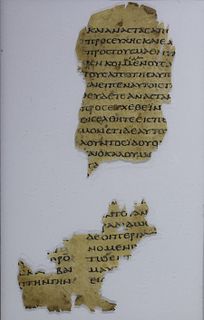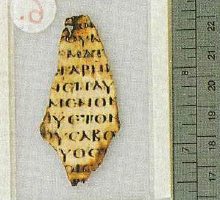| New Testament manuscript | |
| Name | P. Monts. Roca inv. 16 |
|---|---|
| Text | Luke 8:25-27 |
| Date | 5th century |
| Script | Greek |
| Now at | Santa Maria de Montserrat |
| Size | 7 cm by 9.5 cm |
| Type | mixed |
| Category | III |
Uncial 0267 (in the Gregory-Aland numbering), is a Greek uncial manuscript of the New Testament. Palaeographically it has been assigned to the 5th century. [1]
The codex contains a small part of the Gospel of Luke 8:25-27, on 1 parchment leaf (7 cm by 9.5 cm). Probably it was written in one column per page, 10 lines per page, in uncial letters. [1]
Currently it is dated by the INTF to the 5th century. [1] [2]
The text of this codex is too brief to determine its textual character. Aland did not place it in any of Categories of New Testament manuscripts. [1] It was examined by Ramón Roca-Puig, who published its text in 1965. [3]
Currently the codex is housed at the Santa Maria de Montserrat (P. Monts. Roca inv. 16) in Catalonia. [2] It was formerly held at the Fundación Sant Lluc Evangelista (Pap. Barcinonensis, inv. n. 16) in Barcelona. [1]

The "Magdalen" papyrus was purchased in Luxor, Egypt in 1901 by Reverend Charles Bousfield Huleatt (1863–1908), who identified the Greek fragments as portions of the Gospel of Matthew and presented them to Magdalen College, Oxford, where they are cataloged as P. Magdalen Greek 17 and whence they have their name. When the fragments were finally published by Colin H. Roberts in 1953, illustrated with a photograph, the hand was characterized as "an early predecessor of the so-called 'Biblical Uncial'" which began to emerge towards the end of the 2nd century. The uncial style is epitomised by the later biblical Codex Vaticanus and Codex Sinaiticus. Comparative paleographical analysis has remained the methodological key for dating the manuscript, but there is no consensus on the dating of the papyrus. Estimates have ranged from the first century to the fourth century AD.

Uncial 0162, ε 023, is one vellum leaf of a Codex containing The Gospel of John in Greek. It has been paleographically assigned a 3rd or 4th century CE date.

Uncial 0171, ε 07 (Soden) are two vellum leaves of a late third century Greek uncial Bible codex containing fragments of the Gospel of Matthew and the Gospel of Luke. Luke fragment, in two parts, is preserved in the Laurentian Library collection in Florence, and the Matthew fragment is in the Berlin State Museum.

Papyrus 92, designated by 92, is an early New Testament papyrus.

Papyrus 5, designated by siglum 5, is an early copy of the New Testament in Greek. It is a papyrus manuscript of the Gospel of John dating palaeographically to the early 3rd century. The papyrus is housed in the British Library. It has survived in a very fragmentary condition.

Papyrus 30, designated by 30, is an early copy of the New Testament in Greek. It is a papyrus manuscript of the Pauline epistles, it contains only 1 Thess 4:12-5:18. 25-28; 2 Thess 1:1-2; 2:1.9-11. The manuscript paleographically has been assigned to the 3rd century.
Papyrus 80, designed by 80, is an early copy of the New Testament in Greek. It is a papyrus manuscript of the Gospel of John. The surviving text of John is verse 3:34. The manuscript paleographically had been assigned to the 3rd century.
Papyrus 88, designated by 88, is a single leaf from an early copy of the New Testament in Greek. It is a papyrus manuscript of the Gospel of Mark. The surviving texts of Mark are verses 2:1-26. The manuscript palaeographically has been assigned to the 4th century.

Uncial 0169, known also as the Princeton fragment, is a Greek uncial manuscript of the New Testament, dated palaeographically to the 4th century.
Uncial 0206, is a Greek uncial manuscript of the New Testament, dated paleographically to the 4th century.

Uncial 0213 is a Greek uncial manuscript of the New Testament, dated palaeographically to the 5th or 6th century.
Uncial 0216, is a Greek uncial manuscript of the New Testament, dated palaeographically to the 5th century.

Uncial 0228, is a Greek uncial manuscript of the New Testament. The manuscript paleographically had been assigned to the 4th century. It contains a small parts of the Epistle to the Hebrews (12:19-21,23-25), on 1 parchment leaf. Written in one column per page, 17 lines per page.
Uncial 0231, is a Greek uncial manuscript of the New Testament. The manuscript palaeographically has been assigned to the 4th century.
Uncial 0237, ε 014, is a Greek-Coptic uncial manuscript of the New Testament. Paleographically it has been assigned to the 6th-century.
Uncial 0242, is a Greek uncial manuscript of the New Testament. Paleographically it has been assigned to the 4th century.

Uncial 0252, is a Greek uncial manuscript of the New Testament. Paleographically it has been assigned to the 5th century.
The Fundación Sant Lluc Evangelista, was founded in 1952, in Barcelona, by Ramón Roca Puig (1906–2001), Spanish papyrolog and priest from Catalonia, who several times travelled to the Near East, where acquired some important ancient manuscripts.
Uncial 0298, is a Greek-Coptic uncial manuscript of the New Testament. Palaeographically it has been assigned to the 8th or 9th century.
The so-called Alcestis Barcinonensis is a mythological poem of at least 124 Latin hexameters on the story of Alcestis dying for the sake of her husband Admetus, following by and large the play by Euripides. The poem has been written on four papyrus leaves dated to the second half of the fourth century on account of the handwriting, an early half-uncial with cursive elements, and inserted into a codex mixtus at some later point in time. The editio princeps has been published by the Catalan priest and papyrologist Ramon Roca-Puig on 18 October 1982. The papyrus leaves are now in the possession of the foundation Sant Lluc Evangelista founded by Roca-Puig and located in Barcelona.